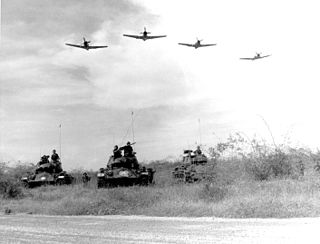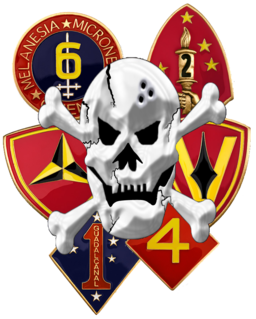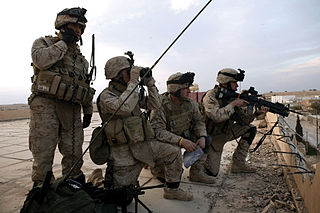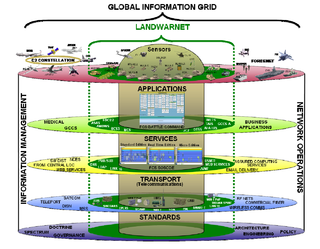Related Research Articles
Military tactics encompasses the art of organizing and employing fighting forces on or near the battlefield. They involve the application of four battlefield functions which are closely related – kinetic or firepower, mobility, protection or security, and shock action. Tactics are a separate function from command and control and logistics. In contemporary military science, tactics are the lowest of three levels of warfighting, the higher levels being the strategic and operational levels. Throughout history, there has been a shifting balance between the four tactical functions, generally based on the application of military technology, which has led to one or more of the tactical functions being dominant for a period of time, usually accompanied by the dominance of an associated fighting arm deployed on the battlefield, such as infantry, artillery, cavalry or tanks.

Combined Arms is an approach to warfare which seeks to integrate different combat arms of a military to achieve mutually complementary effects. According to strategist William S. Lind, combined arms can be distinguished from the concept of "supporting arms" as follows:
Combined arms hits the enemy with two or more arms simultaneously in such a manner that the actions he must take to defend himself from one make him more vulnerable to another. In contrast, supporting arms is hitting the enemy with two or more arms in sequence, or if simultaneously, then in such combination that the actions the enemy must take to defend himself from one also defends himself from the other(s).

In military operations, reconnaissance or scouting is the exploration of an area by military forces to obtain information about enemy forces, terrain, and other activities.
Maneuver warfare, or manoeuvre warfare, is a military strategy which attempts to defeat the enemy by incapacitating their decision-making through shock and disruption.
Principles of war are rules and guidelines that represent truths in the practice of war and military operations.

The United States Marine Corps Reconnaissance Battalions are the Special Operations Capable reconnaissance assets of Marine Air-Ground Task Force that provide division-level ground and amphibious reconnaissance to the Ground Combat Element within the United States Marine Corps. Division reconnaissance teams are employed to observe and report on enemy activity and other information of military significance in close operations. The Military Occupational Specialty code for Reconnaissance Marine is 0321.

Air Naval Gunfire Liaison Company (ANGLICO) is an airborne fire support and liaison unit of the United States Marine Corps. The mission of ANGLICO is "To provide Marine Air-Ground Task Force (MAGTF) Commanders a liaison capability to plan, coordinate, and conduct terminal control of fires in support of joint, allied, and coalition forces." Per this mission statement, ANGLICOs are not designed to support U.S. Marine Corps maneuver elements. Instead, the doctrinal purpose of ANGLICO is to provide fire support and coordination in support of units adjacent to the MAGTF.
Assault Support is one of the six functions of United States Marine Corps aviation and comprises those actions required to airlift personnel, supplies or equipment into or within a battle area by helicopters or fixed-wing aircraft. It provides the Marine Air-Ground Task Force commander the ability to concentrate his strength against selected weaknesses using speed and surprise. It also provides operational and tactical mobility as well as logistics support to the Marine Air-Ground Task Force. It is used to focus combat power at the decisive place and time to achieve local combat superiority.
Distributed Operations (DO) is a war-fighting concept drafted by the United States Marine Corps and developed primarily by their Warfighting Laboratory as a response to the changing environment of the Global War on Terror. Adaptive enemies and a more complex environment were seen as requiring conventional forces to maintain the ability to decentralize decision making and distribute their forces. The overarching goal of DO is to maximize a Marine Air Ground Task Force commander's ability to employ tactical units across the depth and breadth of a non-linear battlespace.
Battlespace or battle-space is a term used to signify a unified military strategy to integrate and combine armed forces for the military theatre of operations, including air, information, land, sea, cyber and outer space to achieve military goals. It includes the environment, factors, and conditions that must be understood to successfully apply combat power, protect the force, or complete the mission. This includes enemy and friendly armed forces, infrastructure, weather, terrain, and the electromagnetic spectrum within the operational areas and areas of interest.
Area of Responsibility (AOR) is a pre-defined geographic region assigned to Combatant commanders of the Unified Command Plan (UCP), that are used to define an area with specific geographic boundaries where they have the authority to plan and conduct operations; for which a force, or component commander bears a certain responsibility. The term may also be used in other countries worldwide but it originated within the United States Armed Forces. This system is designed to allow a single commander to exercise command and control of all military forces in the AOR, regardless of their branch of service.

The FCS Network - Brigade Combat Team (BCT) Network consists of five layers that combine to provide seamless delivery of data to forward-deployed Army units.

Special operations capable (SOC) is a concept and designation developed by the United States Marine Corps and United States Navy concerning select special operations capabilities of Marine Expeditionary Units (MEU).
The United States Marine Corps is assigned by the National Command Authority to be primarily the Department of Defense's expeditionary force-in-readiness, and the Department of the Navy's contingent landing force—amphibious by nature. Before 2006, the Marine Corps was the only branch of the Armed Forces that did not have any of its special warfare elements participating in the United States Special Operations Command (USSOCOM), due to confining its special operations capabilities only for the purpose to the Fleet Marine Force.
The reconnaissance mission within the United States Marine Corps is divided into two distinct but complementary aspects; Marine Division Recon and Force Reconnaissance.

The Marine Raider Regiment, formerly known as the Marine Special Operations Regiment (MSOR), is a special operations force of the United States Marine Corps, part of Marine Corps Special Operations Command (MARSOC). Renamed for its predecessor, the World War II Marine Raiders, this unit is the principal combat component of MARSOC, which is the Marine Corps' contribution to the United States Special Operations Command (USSOCOM).

The United States armed forces classify reconnaissance missions as "close" or "short-range"; "distant" or "medium-range"; and "deep" or "long-range".

Stanley Smith Hughes was raised in Tioga County, Pennsylvania and was of Welsh, German and Native American descent. He joined the Marines in 1940 as an enlisted man and at the start of World War II was selected for officer training. He was assigned as a weapons platoon commander in the First Marine Division. He served in World War II, Korea and Vietnam. In Vietnam as the commander of the First Marine Regiment he conducted the relief operation of the Khe Sanh Combat Base and was in command during the heaviest fighting at the Battle of Hue. He was the only Marine to have been awarded the Navy Cross in both World War II and Vietnam.
The Marine Air Command and Control System (MACCS) is the aviation command and control agencies of the United States Marine Corps that provide the Aviation Combat Element (ACE) commander with the means to monitor, supervise, and influence aviation operations in support of the Marine Air-Ground Task Force. The command and control agencies of the MACCS are provided by the squadrons and battalions of the Marine Air Control Groups that are present within each Marine Air Wing. The capabilities resident within the MACCS allow the MAGTF commander to safely conduct aviation operations, facilitate timely maneuver and prosecution of fires and ultimately retain full control of their entire area of operations. MACCS agencies are also responsible for coordinating Marine Corps aviation operations with joint, multinational and civil aviation.
References
- ↑ Marine Corps Doctrinal Publication 1-0, Marine Corps Operations, (Wash., DC: HQMC, 2001)